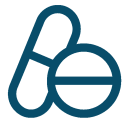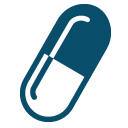What are Headaches & Migraines?
Headaches cause pain in the head, face, or upper neck, and can vary in frequency and intensity. They are caused by damage or dysfunction within the nervous system, also known as neuropathic pain. This is different from nociceptive pain, which occurs when an injury or accident damages your body tissues and activates specialized nerve cells.
Headaches are classified as either primary or secondary.

Primary Headaches
Caused by the activity of or issues with pain-sensitive structures within your head
Examples:
- Migraines
- Tension headaches

Secondary Headaches
A symptom of another issue or condition, such as:
- an infection
- stress
- concussion
- or, just drinking too much the night before
There are many different types of headaches, many of which are not dangerous. However, some headaches can be warning signs of a serious or potentially life-threatening medical condition.

Get emergency care if you experience any of the following:
▢ An abrupt, severe headache that feels like a thunderclap (possible aneurysm)
▢
Any headache that is accompanied by a fever, nausea or vomiting, a stiff neck, mental confusion, seizures, numbness, or speaking difficulties. These can be caused by several different issues including a stroke, meningitis, encephalitis, or a brain tumor
▢
A headache after a head injury, even if it’s a minor fall or bump. This is especially true if the headache starts to worsen
▢
Any sudden, severe headache that you have never experienced before
▢
A headache that gets worse over several days and changes in how you experience it.
[14]
Perimenopause and Headaches
Perimenopause and headaches often occur together because the hormones estrogen and progesterone can affect neurotransmitters in the brain that carry pain signals. Researchers believe that having steady estrogen levels might improve perimenopause headaches and perimenopause migraines, as well as headache and night sweats, while having estrogen levels that dip or change can make headaches worse. This is known as the estrogen-withdrawal theory. [2] [3] [4]
As well, the changing levels of estrogen during perimenopause can increase inflammation throughout the body. Inflammation is known to impact headaches and migraines by making molecules, called inflammasomes, that impact the trigeminal nerve in the face. Inflammation can also press against other nerves surrounding the brain. [5]
Research has found that women with a history of migraines have an increased sensitivity to fluctuations in estrogen levels as the migraines are also associated with estrogen decreases during the menstrual cycle. [4]
One study even proposes a new category of headache – the ‘menstrual migraine’ or ‘hormonally associated migraine’. This can be identified by severe migraine pain occurring regularly in the period between the 2 days before and 3 days after menstruation. The symptoms are more intense, do not include an aura, and last longer than typical non-menstrual migraines, which last from 4 hours to 3 days. It appears that menstrual migraines are affected by estrogen levels but migraines with an aura are not as impacted. [6] [7]
One review paper concluded that estrogen seems to affect patients in different ways depending on their medical history, their age and whether or not they are taking any hormonal therapy. For some women, migraines appear for the first time during perimenopause, whereas for other women who do experience migraines may find they go away when perimenopause starts. [4]
Types of Headaches
The main types of headache that can be affected by the menopausal transition are:
- migraine (primary)
- tension headache (primary)
- cluster headache (secondary)
- sinus headache (secondary)
- chronic daily headache (secondary)
Self-Care & Natural Remedies for Headaches & Migraines
Headaches can be awful. While headaches can have multiple causes, self care for one type of headache is very likely to help with other types of headaches. Try any of the following to see what is most effective for you and the headaches that you experience.
At home treatment for your head pain can include any or all of the following:
➜ Relaxation exercises to lower stress and anxiety
➜ Learn and practice biofeedback techniques you to monitor and understand how your body responds to stress
➜ Acupuncture and or massage may help you relax
➜ Over-the-counter pain relievers such as ibuprofen or aspirin
➜ Over-the-counter allergy medications
➜ Practicing meditation and mindfulness exercises
➜ Practicing good sleep habits
➜ Rest in a comfortable position (whatever works to ease the pain) in a room with low sensory stimulation (low noise levels, low light levels etc.)
Therapies & Treatments for Menopause Headaches & Migraines
At age 40 find a reliable, educated primary care provider familiar with recognizing and treating symptoms of perimenopause and menopause. The North American Menopause Society provides a list of menopause practitioners here.
If you have tried self-care and your headaches are still problematic, work with your doctor to find relief with medical alternatives. The following medications may be helpful:
The Science
Estrogen is linked with inflammation, and research clearly shows that lowered levels of estrogen are associated with inflammation throughout the body. [19] Migraines are caused when the trigeminovascular system in the brain becomes inflamed. The trigeminovascular system is made up of trigeminal neurons that connect to the blood vessels in the brain and the dura. Inflammasomes are molecules that can cause the production of inflammatory cytokines, which are signaling molecules. When inflammasomes signal and stimulate the trigeminal neurons, they get inflamed and cause migraine headaches. [20] [21]
Migraines are more common in women than in men and sex hormones are believed play a large part in the difference. Fluctuations of estrogen and progesterone are believed to impact the origins and development of migraine due to the inflammatory influence of these hormones. [22] Additionally estrogen is known to influence pain sensitivity and study results are clear that women’s pain threshold and pain tolerance varies depending on the stage of their menstrual cycle. [23] Post-menopausal women with neuropathic pain, including headache pain, had significantly lower estrogen and progesterone levels as compared to control subjects. [24]

Neuropathic Pain
Neuropathic pain is caused by damage or dysfunction (such as inflammation, irritation, or neural tissue compression) within the nervous system itself. The damaged nerve cells can send spontaneous signals to the brain that are interpreted and felt as pain or the damaged cells can amplify normal pain responses.
Neuropathic pain can be chronic – lasting more than 6 months – or it can be resolved if the underlying damage is fixed. For example, inflammation in a tissue can press on nerve cells causing them to signal pain to the brain. If the inflammation goes away – say through the use of anti-inflammatory drugs – the pressure on the nerve cells will also go away and the pain will stop.

Nocioceptive Pain
Nociceptive pain is caused by any damage to body tissues that activates specialized nerve cells (nocioceptors) through a direct stimulus. Once they are activated, the nociceptors transmit signals to the brain that cause a protective response.
For example, if the nociceptors detect an extreme temperature and signal your brain, your brain will, in turn, signal your muscles to pull your hand away from the stove. Nociceptive pain goes away when the stimulus (in this example, the hot temperature) stops.
There are both natural treatments and medical support for headaches and migraines.
A few natural methods of relief are:
- Using a cold cloth or an ice pack held against the painful area on your head or neck. You can wrap the ice pack in a towel to protect your skin
- Relaxation exercises to lower stress and anxiety
- Learn and practice biofeedback techniques you to monitor and understand how your body responds to stress
More on Self-care & Natural Remedies for Headaches & Migraines
If you have tried self-care and your headaches are still problematic, work with your doctor to find relief with medical alternatives. The following medications may be helpful:
- Nonsteroidal anti-inflammatory drugs (NSAIDs).
- Triptans.
- Gepants.
- Hormone therapy.
- Botox.
More on Therapy & Treatment for Headaches & Migraines
There are both natural treatments and medical support for headaches and migraines.
A few natural methods of relief are:
- Using a cold cloth or an ice pack held against the painful area on your head or neck. You can wrap the ice pack in a towel to protect your skin
- Relaxation exercises to lower stress and anxiety
- Learn and practice biofeedback techniques you to monitor and understand how your body responds to stress
More on Self-care & Natural Remedies for Headaches & Migraines
If you have tried self-care and your headaches are still problematic, work with your doctor to find relief with medical alternatives. The following medications may be helpful:
- Nonsteroidal anti-inflammatory drugs (NSAIDs).
- Triptans.
- Gepants.
- Hormone therapy.
- Botox.
More on Therapy & Treatment for Headaches & Migraines
Headaches cause pain in the head, face, or upper neck, and can vary in frequency and intensity. They are classified as either primary or secondary headaches. Primary headaches are caused by the activity of or issues with pain-sensitive structures within your head. Migraine and tension headaches are examples of primary headaches. Secondary headaches are a symptom of another issue or condition, such as an infection, stress, concussion, or just drinking too much the night before. [1]
Learn more here
MYTH
Big stressors such as moving, starting a new job, or seeing your family over the holidays can definitely have an impact. However, the everyday stressors like traffic jams, running late to pick up the kids from daycare, or misplacing your keys are the most likely triggers for tension headaches. Not only are these stressful on their own, they can also cause you to physically tense up or clench and tighten your jaw. These in turn can trigger tension headaches or make them much more likely.
FALSE
Nope. Not true.
There are multiple treatment options available. While medications are often effective and available, they can become part of the problem if they are used too frequently.
Experiment with at-home treatments such as meditation and mindfulness practices, or dietary detox (eliminating different food groups and seeing if there is any change in your condition when you, for example, stop eating dairy or soy products). Talk to your healthcare provider about all of your options.
While this is true to a certain extent, if you suffer from frequent migraines and you take medication for them, you are at risk of a condition called medication-overuse headaches. Talk to your healthcare provider about finding alternative treatments if you suffer from frequent headaches or migraines and use medications to con
MYTH
Caffeine can trigger headaches, but it can also relieve them. Caffeine is a vasoconstrictor that causes blood vessels to narrow and restrict the flow of blood. This can help reduce headache pain. When caffeine is combined with nonsteroidal anti-inflammatory drugs (NSAIDs) such as aspirin or ibuprofen, studies have shown that the pain relief is boosted by up to 40%.
Having a cup of coffee when you feel a headache coming on may be helpful, but remember, too much caffeine, or rather the withdrawal of caffeine, can also cause headaches. If you have been drinking a lot of caffeine and you stop or slow down your consumption, your body can go into withdrawal and you can get a headache as a result. If you are planning on reducing your caffeine intake, remember to do it slowly!
FALSE
Headaches and migraines are often separated from each other based on the presence of an aura before the pain starts. The aura is usually experienced as visual disturbances or hallucinations such as flashes of light. In fact, less than one third of migraines have a distinct aura stage.
FALSE
A migraine involves more than a typical headache. In fact, headaches are often one of many symptoms of migraine. These other symptoms can include sensitivity to light and noise, nausea, weakness, and vision problems all of which can be as disabling as the headache pain.
[1] https://cornellpainclinic.com/conditions-treated/headaches/
[3]https://www.mayoclinic.org/diseases-conditions/cluster-headache/symptoms-causes/syc-20352080
[4] Biondi DM. Is migraine a neuropathic pain syndrome? Curr Pain Headache Rep. 2006 Jun;10(3):167-78. doi: 10.1007/s11916-006-0042-y. PMID: 18778570.
[5] https://www.healthline.com/health/menopause/pain#changes
[7] https://www.mayoclinic.org/diseases-conditions/tension-headache/symptoms-causes/syc-20353977
[8] https://www.medicalnewstoday.com/articles/179211
[9] https://www.webmd.com/migraines-headaches/triptans-migraines
[11] https://www.hopkinsmedicine.org/health/treatment-tests-and-therapies/botulinum-toxin-injectables-for-migraines
[11a] McCarthy, M., Raval, A.P. The peri-menopause in a woman’s life: a systemic inflammatory phase that enables later neurodegenerative disease. J Neuroinflammation 17, 317 (2020). https://doi.org/10.1186/s12974-020-01998-9
[12] D. Ruthirago, P. Julayanont, J. Kim, (2017) Chapter 7.2 – Translational Correlation: Migraine, Conn’s Translational Neuroscience, Academic Press, pp 159-165,
https://doi.org/10.1016/B978-0-12-802381-5.00013-0.
[13] Kursun, O., Yemisci, M., van den Maagdenberg, A.M.J.M. et al. Migraine and neuroinflammation: the inflammasome perspective. J Headache Pain 22, 55 (2021). https://doi.org/10.1186/s10194-021-01271-1
[14] Hassany, L., Haas, J., Piccininni, M., Kurth, T., Maassen Van Den Brink, A., & Rohmann J. L. (2020) Giving Researchers a Headache – Sex and Gender Differences in Migraine Frontiers in Neurology https://doi.org/10.3389/fneur.2020.549038
[15] Wiesenfeld-Hallin Z. Sex differences in pain perception. Gend Med. 2005 Sep;2(3):137-45. doi: 10.1016/s1550-8579(05)80042-7. PMID: 16290886.
[16] Singh, A., Asif, N., Singh, P. N., & Hossain, M. M. (2016). Motor Nerve Conduction Velocity In Postmenopausal Women with Peripheral Neuropathy. Journal of clinical and diagnostic research : JCDR, 10(12), CC13–CC16. https://doi.org/10.7860/JCDR/2016/23433.9004
[16a] https://www.medicalnewstoday.com/articles/depression-headaches#causes
Original content, last updated February 6, 2025.
© 2025 Herstasis® Health Foundation















